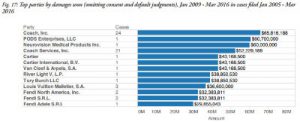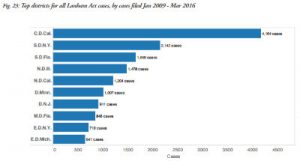 On Monday, May 23rd, legal analytics firm Lex Machina released a report detailing trends in trademark litigation in recent years leading up to March 2016, in many cases going back to January 2009. The report identifies top trademark litigants, damages awarded and the most common judgements being handed down in these cases. For attorneys involved with trademark litigation work, the report also contains some valuable information on case timing which can help them budget better for litigation. The report only looks at trademark cases; any cases involving both patents and trademarks have been culled from the statistics.
On Monday, May 23rd, legal analytics firm Lex Machina released a report detailing trends in trademark litigation in recent years leading up to March 2016, in many cases going back to January 2009. The report identifies top trademark litigants, damages awarded and the most common judgements being handed down in these cases. For attorneys involved with trademark litigation work, the report also contains some valuable information on case timing which can help them budget better for litigation. The report only looks at trademark cases; any cases involving both patents and trademarks have been culled from the statistics.
 When looking at damages awarded in trademark infringement cases filed since 2005 and terminating between 2009 and 2016, fashion brands have taken in the highest award totals. The top spot here belongs to Parisian fashion brand Chanel, which has been awarded nearly $1 billion dollars from 160 infringement cases resulting in awards out of the 330 cases filed by Chanel. That’s almost double the $523 million awarded to Burberry Limited but its sibling Burberry Limited UK was awarded $416.6 million and those totals were awarded over the course of a combined 12 infringement cases. In terms of damage totals, there’s another steep drop to Gucci of Florence, Italy, which was awarded $207.7 million over the course of 26 cases.
When looking at damages awarded in trademark infringement cases filed since 2005 and terminating between 2009 and 2016, fashion brands have taken in the highest award totals. The top spot here belongs to Parisian fashion brand Chanel, which has been awarded nearly $1 billion dollars from 160 infringement cases resulting in awards out of the 330 cases filed by Chanel. That’s almost double the $523 million awarded to Burberry Limited but its sibling Burberry Limited UK was awarded $416.6 million and those totals were awarded over the course of a combined 12 infringement cases. In terms of damage totals, there’s another steep drop to Gucci of Florence, Italy, which was awarded $207.7 million over the course of 26 cases.
Although fashion brands are earning the highest number of damages from its trademark infringement suits, it does not necessarily follow that these brands are the most valuable but perhaps the easiest to copy. We got a chance to speak with Brian Howard, Lex Machina legal data scientist and a co-author of the report, and he noted that unlike patents, where IP owners can wait to file suit after infringement has been spotted, trademark owners must protect their mark quickly or risk losing their rights to the mark. “I think the amount of damages [fashion brands] get is probably less a function of the value of their trademark and more a function of the fact they have to pursue all of these counterfeiters,” Howard said.
Other trends noted by the report raise a good question as to whether much of these damages will ever actually be obtained by these brands. The recent report finds that 68 percent of all Lanham Act violation findings lead to a default judgement. Looking at it from another perspective, 98 percent of the default judgements handed down between January 2009 and March 2016 were related to Lanham Act violations. “Anything that’s awarded on default, you have to be a little skeptical on the ability to collect,” Howard said.
 To get a clearer idea of damage awards that might be reasonably collected, the Lex Machina report also includes data on damage totals minus default or consent judgements. American luxury brand Coach, which filed the most trademark infringement cases between January 2009 and March 2016 (730 cases), places seventh in total damages but it’s first overall when it comes to damages when omitting default and consent judgements ($65.8 million). In this field, second-place PODS Enterprises, a storage brand, and third-place Neurovision Medical Products were both awarded around $60 million.
To get a clearer idea of damage awards that might be reasonably collected, the Lex Machina report also includes data on damage totals minus default or consent judgements. American luxury brand Coach, which filed the most trademark infringement cases between January 2009 and March 2016 (730 cases), places seventh in total damages but it’s first overall when it comes to damages when omitting default and consent judgements ($65.8 million). In this field, second-place PODS Enterprises, a storage brand, and third-place Neurovision Medical Products were both awarded around $60 million.
 To clean up the data surrounding damages and understand more of the effects of default judgements on damage totals, this report includes a new damages category called “mass counterfeiter default damages.” As Howard explains, these damages come from cases where plaintiffs are mass-suing a large number of defendants on allegations of counterfeiting false goods and the damage awards issue from a default judgement. “It gives a much more realistic sense [of trademark damages] without default damages dragging the average upward,” Howard said. For cybersquatting cases where an online domain name infringes on a trademark, mass counterfeiter default damages are most often awarded at the $10,000 level. For other Lanham Act violations, mass counterfeiter default damages are most commonly seen at the $2 million level where they’ve been awarded in 186 cases.
To clean up the data surrounding damages and understand more of the effects of default judgements on damage totals, this report includes a new damages category called “mass counterfeiter default damages.” As Howard explains, these damages come from cases where plaintiffs are mass-suing a large number of defendants on allegations of counterfeiting false goods and the damage awards issue from a default judgement. “It gives a much more realistic sense [of trademark damages] without default damages dragging the average upward,” Howard said. For cybersquatting cases where an online domain name infringes on a trademark, mass counterfeiter default damages are most often awarded at the $10,000 level. For other Lanham Act violations, mass counterfeiter default damages are most commonly seen at the $2 million level where they’ve been awarded in 186 cases.
Injunction and remedy timing statistics are also included in this report. The median time to receive a preliminary injunction was just over one month for cases filed between 2009 and 2016. Half of all preliminary injunctions were awarded between 0.6 months and 2.6 months. Permanent injunctions were issued at a median of six months, with half of all such injunctions awarded between 3.2 months and 10.8 months. For temporary restraining orders, trademark cases reached that remedy at a median of seven days and half of all such restraining orders were issued between two and 15 days. Generally speaking, cybersquatting cases reach these forms of injunctive relief at a slightly quicker pace while false advertising charges take longer to reach relief than general trademark cases. Although this information isn’t incredibly eye-grabbing, Howard stated that it’s probably among the most valuable parts of the report. “Timing informs budget and schedule,” he said. “It’s an example of how quantitative information can support the process and help people make better decisions.”
 Anyone following trends in the patent litigation world knows that the issue of venue has been a controversial one in recent years. In the trademark litigation sphere, there’s a venue that’s clearly preferred but the reasons are perhaps more rational than the high percentage of patent cases which head to Marshall, TX. The U.S. District Court for the Central District of California (C.D.Cal.) saw 4,164 Lanham Act cases filed between 2009 and 2016. That’s almost double the amount of cases filed in the Southern District of New York (S.D.N.Y.), where 2,142 Lanham Act cases were filed from 2009 to 2016. Third-place in this regard was the Southern District of Florida (S.D.Fla.) which saw 1,659 such cases during that time period. The reason why most cases have sought these venues is likely because they include major metropolitan cities where the fashion industry is strong, including Los Angeles, New York and Miami. With the high number of fashion brands bringing trademark infringement cases to court, it stands to reason that those cases would take place at the district courts which hold jurisdiction over these cities.
Anyone following trends in the patent litigation world knows that the issue of venue has been a controversial one in recent years. In the trademark litigation sphere, there’s a venue that’s clearly preferred but the reasons are perhaps more rational than the high percentage of patent cases which head to Marshall, TX. The U.S. District Court for the Central District of California (C.D.Cal.) saw 4,164 Lanham Act cases filed between 2009 and 2016. That’s almost double the amount of cases filed in the Southern District of New York (S.D.N.Y.), where 2,142 Lanham Act cases were filed from 2009 to 2016. Third-place in this regard was the Southern District of Florida (S.D.Fla.) which saw 1,659 such cases during that time period. The reason why most cases have sought these venues is likely because they include major metropolitan cities where the fashion industry is strong, including Los Angeles, New York and Miami. With the high number of fashion brands bringing trademark infringement cases to court, it stands to reason that those cases would take place at the district courts which hold jurisdiction over these cities.
The recent Lex Machina trademark litigation report also looks at infringement cases filed in the first quarter of 2016 and the top plaintiff during that three-month period was Sream, Inc., which brought 55 such cases to court. As this October 2014 decision from a C.D.Cal. judge will show readers, Sream actively enforces on its RooR trademark rights. If you don’t recognize that brand name, then you’ve likely never had to worry about a drug test barring you from employment: RooR is a brand of bongs, water pipes and other smoking accessories prized by those who imbibe certain mood-altering substances, primarily marijuana. It’s very interesting to consider the fact that the nascent legal marijuana industry is using the American court system to protect its property rights; it’s a sign that we’re pretty far removed from the legal perspective of the substance which arose during and followed the Nixon Administration.

![[IPWatchdog Logo]](https://ipwatchdog.com/wp-content/themes/IPWatchdog%20-%202023/assets/images/temp/logo-small@2x.png)

![[Advertisement]](https://ipwatchdog.com/wp-content/uploads/2024/04/Patent-Litigation-Masters-2024-sidebar-early-bird-ends-Apr-21-last-chance-700x500-1.jpg)

![[Advertisement]](https://ipwatchdog.com/wp-content/uploads/2021/12/WEBINAR-336-x-280-px.png)
![[Advertisement]](https://ipwatchdog.com/wp-content/uploads/2021/12/2021-Patent-Practice-on-Demand-recorded-Feb-2021-336-x-280.jpg)
![[Advertisement]](https://ipwatchdog.com/wp-content/uploads/2021/12/Ad-4-The-Invent-Patent-System™.png)







Join the Discussion
No comments yet.